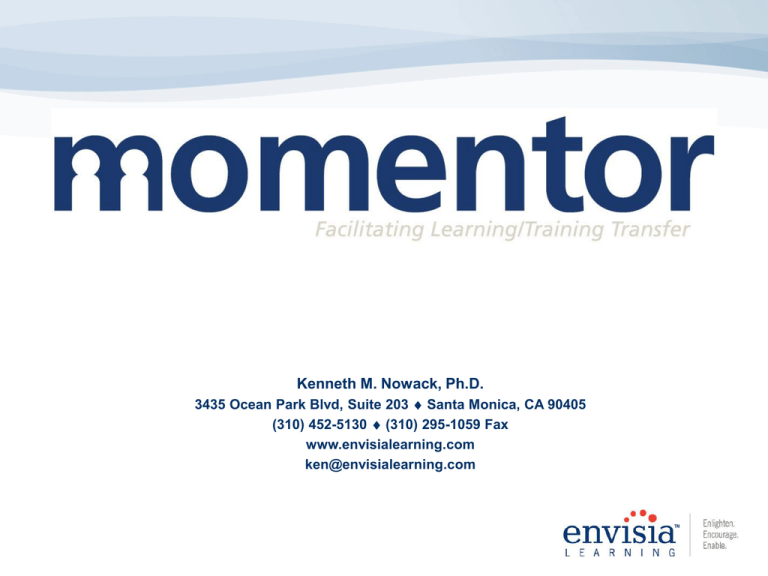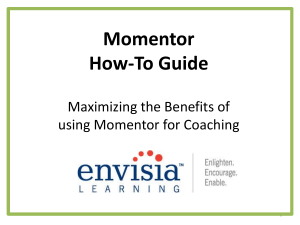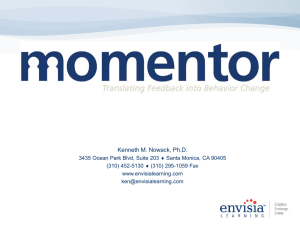Organizational Performance Dimensions
advertisement

Kenneth M. Nowack, Ph.D. 3435 Ocean Park Blvd, Suite 203 Santa Monica, CA 90405 (310) 452-5130 (310) 295-1059 Fax www.envisialearning.com ken@envisialearning.com Who we are… Envisia Learning is a leader in providing innovative assessment products, services, and other internet based resources that are responsive to the unique needs of consultants and coaches and the individuals they serve throughout the world. We are committed to building strong, mutually beneficial, and enduring relationships with a focus on providing superior customer service, high-quality products, and excellent price value to our Customers. Does Training Work? Training: Benefit or Business Driver? Talent Expectation Business Driver Participate Participate Appreciate Learn and Apply The Cost Expenditure of Training U.S. firms spent about $156 billion on employee learning in 2011 Leading training areas included: Managerial/supervisory Profession/industry specific Process, procedures and practices 2012 ASTD State of the Industry Report Without follow-up, 90% of new skills are lost within a year (Salas, 2012) Only 10% of what’s invested into training programs results in employees transferring what they’ve learned back to their jobs (Knyphausen-Aufsess, Smukalla, & Abt, 2009). The Training Impact Distribution (Brinkerhoff, 2012) The ROI of Training Fact #1 In recent meta-analyses reviewing training effectiveness, the average effect sizes (learning .17 to behavior change .3) suggest only modest change in behavior raising a question about the ROI Powell, K. S., & Yalcin, S. (2010). Managerial training effectiveness. Personnel Review, 39, 227–241. Taylor, P. J., Russ-Eft, D. F., & Chan, D. L. (2005). A meta-analytic review of behavior modeling training. Journal of Applied Psychology, 90, 692–709. The ROI of Training Fact #2 In a study of seven companies, training participants were asked if they intended to apply what they learned on the job— nearly 100 percent said “yes” but 30 percent of direct reports said their bosses did absolutely nothing When leaders did little or no follow-up with their direct reports (e.g., asking for additional feedback, sharing information about what skills they were trying to develop further) there was no perceived change in the leaders overall effectiveness Goldsmith, M. & Morgan, H. Leadership is a contact sport: The "follow up" factor in management development. Strategy+Business, 36, 71-79 The ROI of Training Fact #3 Martin (2010) found a positive effect on learning transfer for peer support in a corporate field environment, with peer support and encouragement mitigating a negative work climate Martin, H. J. (2010). Workplace climate and peer support as determinants of training transfer. Human Resource Development Quarterly, 21, 87-104 Managers who follow-up with talent who have taken 360-degree feedback assessments are more likely to set specific goals, solicit ideas for improvement, and subsequently receive improved performance ratings. Smither, J., London, M., Flautt, R., Vargas, Y., & Kucine, I. (2003). Can working with an executive coach improve multisource feedback ratings over time? A quasi-experimental field study. Personnel Psychology, 56, 23–44 The ROI of Training Fact #4 The ROI of Training: The Four Legs The Trainer The Learner The Leader The Work Environment What are the necessary conditions to initiate and successfully maintain new behaviors? Necessary Ingredients for Behavior Change Mashihi, S. & Nowack, K. (2011). Clueless: Coaching People Who Just Don’t Get It Enlighten • Assessment & Feedback Process (awareness of ideal self vs real self, strengths and potential development areas) • Readiness to change (clarification of motivations and beliefs) Encourage • Goal implementation intentions (measurable and specific) • Skill building Enable • Track & social support to reinforce learning • Relapse prevention training • Evaluation (knowledge acquisition, skill transfer, impact) Challenge #1 Acquiring New Behaviors Rhodes, Plotnikoff & Courneya (2009) Frequently people underestimate the difficulty of sustained behavior change A key to developing and enhancing new skills is varied deliberate practice There are different predictors of non-intenders to successful adopters (e.g., readiness to change) versus unsuccessful maintainers versus successful maintainers (e.g., perceived control and efficacy) Challenge #2 Creating Practice Plans Goal intentions alone may not always result in successful maintenance of behavior over time (Lawton, Cooner, & McEachan, 2009) SMART goals aren’t always that smart Format is important! “If-then” statements maximize success Behavior must be observable and measurable Over a decade of research and nearly a hundred studies have shown that Practice Plans double a person’s likelihood of achieving their goals (Gollwitzer & Sheeran, 2006) Challenge #3 How Long it Takes to Form a Habit The number of days it takes for a new behavior to become “automatic” depends on its complexity (e.g., new eating habits 65 days and exercise 91 days) Lally et al., 2009 Days to Become Automatic Typically, the development of expertise in a complex activity requires at least 10 years and/or 10,000 hours of deliberate practice Ericsson, K., 2006 Hours of Practice Challenge #4 Leader as Performance Coach A 2008 survey of over 2,000 international employees and 60 HR leaders reported that 84% of managers are expected to coach talent but only 52% actually do (39% in Europe) Only 24% of all leaders are rewarded or recognized for coaching and developing talent 85% of all managers and employees see value in leaders as coaches but 32% of managers reported it takes too much time and interferes with their job The Coaching Conundrum 2009: Building a coaching culture that drives organizational success. Blessing White Inc. Global Executive Summary Challenge # 5 Developing Leaders: 70/20/10 Rule Formal Learning Feedback & Coaching Job change Special projects and assignments Exposure and involvement in key business challenges Task forces, committees, change initiatives Job Performance feedback Executive coaching 360-degree feedback process Developmental assessment workshops Critical skill building training programs Transition training programs Key external executive programs Self-directed learning initiatives Ascending Value Experience Lombardo & Eichinger (1996) Translating Training into Successful Behavior Change Conscious Incompetence Conscious Competence Unconscious Incompetence Unconscious Competence Training & Coaching Programs Momentor & Goal Evaluation Orchestral musicians preferred creating music when they were encouraged to mindfully incorporate subtle nuances into their performance The practice of staying acutely aware of what is happening in the present moment prevents mindless competence and the use of mindful competence increases creativity, productivity and engagement Russel, T. & Eisenkraft, N. (2009). Orchestral performance and the footprint of mindfulness. Psychology of Music, 37, 125-136. Competence Unconscious Competence Performance (Attention & Passion) Mindless Competence Inattention & Indifference Low Audience members were played recordings of both types of performance and a significant majority expressed a preference for the performances that were created in a mindful state Mindful High Unconscious Competence and Peak Performance A Better Model for Performance…. Or, Stop Evaluating “Training” Define Business Driver Provide Targeted Learning Intervention Reinforce Performance Improvement Momentor Learning Transfer System Translating Training into Successful Behavior Change Momentor for Training An online personal development platform to support the transfer of learning into sustained behaviour change. As soon as you’ve selected your goal, Momentor sends out a reminder email every week asking participants about their progress and reminding them of their goals. Research suggests that implementation intentions coupled with reminders result in greater behavior change. Momentor Features Goal Implementation and Reminder System Development Resource Library Selection of training content related competencies to focus Step 1 professional development plans Assess 360 Development Partner Portal Website portal for training participant’s managers, mentors, internal/external coaches and HR to track and monitor development plans Over 2,000 developmental tips, suggested books, articles, websites, audio/video and other resources mapped to training content competencies Participants in a training and development Assessment program set (or are assigned) goals for Ability to have applying what they have customized resource learned libraries for your organization Progress Pulse: Goal Evaluation System ProgressPulse is a brief goal evaluation system initiated by participants to measure perceived effectiveness of their behavior change efforts Unlimited number of development partners can be invited by the participant Participants can invite any development partners they want (e.g., their manager, direct reports, colleagues, customers) and they will be sent a brief goal effectiveness survey measuring perceived change in effectiveness tied to a specific development goal they are working on Development partners can communicate, reinforce and support learning transfer through this portal A brief web based report will summarize perceived goal success along with open-ended comments by invited raters Direct access to our development resource library to make suggestions for participants to use Weekly reminders to reinforce deliberateStep 2 practice of new Reflect/Plan behaviors Momentor Translating Training into Successful Behavior Change Participant Login and Welcome Page Selecting Development Areas Momentor Goal Setting Options Step 1 Assess 360 Assessment Stop Doing Do Less Step 2 Reflect/Plan Momentor Start Doing Do More Do Regularly Step 3 Track/Monitor Coach Accelerator Setting Development Goals Use our Suggestions or Select Your Own From Goal Intentions to Implementation Action Items, Practice Plans, Goal Mentors & Goal Evaluation Setting Development Goals Action Items and Practice Plans Action Items Practice Plans • Action items are tasks or things that you can easily identify as either completed or incomplete • Add your own or select from our recommended actions Items from our resource library • Practice Plans have two parts. The first is the situation, or the trigger, where you'd like to behave differently when it occurs. • The second part is the what you commit to do more, less or differently when you experience the trigger Setting Development Goals--Action Items Setting Development Goals--Action Items The Psychology of Habits Reward Behavior Practice Plans Creating Practice Plans Gollwitzer & Sheeran (2006) Goal Intention Example Practice Plans Example • “To stay calm in anxiety producing situations” • “If my heart starts to race, then I will begin using my breathing technique and focus on how relaxed I begin to feel” Creating Practice Plans Creating Practice Plans Defining a Developmental Goal Using Our Suggestions Setting Development Goals Use our Suggestions or Select Your Own Selecting Resources to Support Your Goal: Using Our Competency Based Library and Most Popular Resources Selecting Goal Mentors Tracking Development Progress Competency Based Resource Library Content is maintained and updated weekly by a human resources staff member Industry specific competency libraries (e.g., healthcare, sales) Resource categories include: • Books • Websites/Blogs • Audio • Video • Articles • Workshops/Seminars Competency Based Resource Library Example Content from Our Resource Library Example Content from Our Resource Library Selecting Goal Mentors Momentor Reminders to Facilitate Behavior Change Momentor sends out a reminder email every week asking participants about their progress and reminding them of their goals Research suggests that implementation intentions coupled with reminders result in greater behavior change Sheer an, P. et al. (2005). The interplay between goal intentions and implementation intentions. Personality & Social Psychology Bulletin, 31, 87-97 Prestwich, A. et al. (2010). Can implementation intentions and text messages promote brisk walking: A randomized trial. Health Psychology, 29-40-49. Settings/Preferences Help and Support Goal Evaluation Description Is not a 360 feedback assessment Provides a metric of actual behavior change Provides coaches and organizations with a tool to demonstrate the value of their training interventions Goal Evaluation—Summarizing Goals Goal Rater Nomination Momentor Goal Evaluation Goal Evaluation Getting Feedback on Your Goals Goal Evaluation Goal Evaluation “Life is change. Growth is optional. Choose wisely.” Karen Kaiser Clark Behavior Change Selected References Knyphausen-Aufsess, D., Smukalla M., and Abt, M. (2009). Towards a new training transfer portfolio: A review of training-related studies in the last decade. German Journal of Research in Human Resource Management, 23, 288-311. Nowack, K. & Mashihi, S. (2012). Evidence Based Answers to Ten Questions about Leveraging 360-Degree Feedback. Consulting Psychology Journal: Practice and Research, 64, 157–182 Mashihi, S. & Nowack, K. (2011). Clueless: Coaching People Who Just Don’t Get It. Envisia Learning, Santa Monica, CA. Nowack, K. (2009). Leveraging Multirater Feedback to Facilitate Successful Behavioral Change. Consulting Psychology Journal: Practice and Research, 61, 280-297 Nowack, K. (2006). Emotional Intelligence: Leaders Make a Difference. HR Trends, 17, 40-42 Nowack, K. (1999). 360-Degree feedback. In DG Langdon, KS Whiteside, & MM McKenna (Eds.), Intervention: 50 Performance Technology Tools, San Francisco, Jossey-Bass, Inc., pp.34-46. Nowack, K., Hartley, G, & Bradley, W. (1999). Evaluating results of your 360-degree feedback intervention. Training and Development, 53, 48-53. Nowack, K. (1999). Manager View/360. In Fleenor, J. & Leslie, J. (Eds.). Feedback to managers: A review and comparison of sixteen multi-rater feedback instruments (3rd edition). Center for Creative Leadership, Greensboro, NC., Wimer & Nowack (1998). 13 Common mistakes in implementing multi-rater systems. Training and Development, 52, 6979. Nowack, K. & Wimer, S. (1997). Coaching for human performance. Training and Development, 51, 28-32. Nowack, K. (1997). Congruence between self and other ratings and assessment center performance. Journal of Social Behavior & Personality, 12, 145-166 Nowack, K. (1994). The secrets of succession. Training & Development, 48, 49-54 Nowack, K. (1993). 360-degree feedback: The whole story. Training & Development, 47, 69-72 Nowack, K. (1992). Self-assessment and rater-assessment as a dimension of management development. Human Resources Development Quarterly, 3, 141-155. Salas, E., Tannenbaum, S., Kriger, K. & Smith-Jentsch, K. (2012). The science of training and development in organizations: What matters in practice. Psychological Science in the Public Interest, 13, 74-101.









